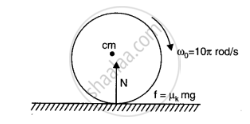Advertisements
Advertisements
प्रश्न
A solid disc and a ring, both of radius 10 cm are placed on a horizontal table simultaneously, with initial angular speed equal to 10 π rad s-1. Which of the two will start to roll earlier? The coefficient of kinetic friction is μk = 0.2.
उत्तर १
Disc Radii of the ring and the disc, r = 10 cm = 0.1 m
Initial angular speed, ω0 =10 π rad s–1
Coefficient of kinetic friction, μk = 0.2
Initial velocity of both the objects, u = 0
Motion of the two objects is caused by frictional force. As per Newton’s second law of motion, we have frictional force, f = ma
μkmg= ma
Where,
a = Acceleration produced in the objects
m = Mass
∴a = μkg … (i)
As per the first equation of motion, the final velocity of the objects can be obtained as:
v = u + at
= 0 + μkgt
= μkgt … (ii)
The torque applied by the frictional force will act in perpendicularly outward direction and cause the reduction in the initial angular speed.
Torque, τ= –Iα
α = Angular acceleration
μxmgr = –Iα
`:.alpha = (-mu_kmgr)/I` ....(iii)
Using the first equation of rotational motion to obtain the final angular speed:
`omega = omega_0 + alphat`
`= omega_0 + (-mu_kmgr)/It` ....(iv)
Rolling starts when linear velocity, v = rω
`:.v= r(omega_0 - (mu_kgmrt)/I)` ...(v)
Equating equations (ii) and (v), we get:
`mu_kgt = r (omega_0 - (mu_kgmrt)/I)`
`= romega_0 - (mu_kgmr^2t)/I` .....(vi)
For the ring: `I =mr^2`
`:. mu"gt" = romega_0 - (mu_kgmr^2t)/(mr^2)`
`= romega_0 -mu_kgmt_r`
`2mu_k"gt" = romega_0`
`:. t_r = (rw_0)/(2mu_kg)`
`= (0.1xx10xx3.14)/(2xx0.2xx9.8) = 0.80s` .....(vii)
For the disc: `I = 1/2mr^2`
`:.mu_k"gt"_d = rw_0 (mukgmr^2t)/(1/2mr^2)`
`= romega_0 - 2mu_k"gt"`
`3mu_k"gt"_d = romega_0`
`:.t_d = (romega_0)/(3mu_kg)`
`= (0.1xx10xx3.14)/(3xx0.2xx9.8) = 0.53 s` ...(viii)
Since `t_d > t_r` the disc will start rolling before the ring.
उत्तर २
When a disc or ring starts rotatory motion on a horizontal surface, an initial translational velocity of the centre of mass is zero.

The frictional force causes the centre of mass to accelerate linearly but frictional torque causes angular retardation. As force of normal reaction N = mg, hence frictional force f = uk N = uk mg.
For linear motion f = uk . mg = ma ———-(i)
and for rotational motion `t = f.R = mu_k mg.R = -ialpha` ....(ii)
Let perfect rolling motion starts at time t, when `v = Romega`
From (i) `a = mu_k.g`
`v = u + at = 0 + mu_k.g.t`
From (ii) `alpha = - (mu_k.mgR)/I = -( mu_k.mgR)/(mK^2) = - (mu_k.gR)/K^2` ....(iii)
`:. omega = omega_0 + alphat = omega_0 - (mu_k.gR)/K^2 t` ...(iv)
Since `v = Romega =, "hence " mu_k.g.t = R[omega_0 - mu_k. (gR)/K^2t]`
`=> t^2 = (Romega_0)/(mu_k .g(1+R^2/K^2))`
For disc `K^2 = R^2/2, "hence " t = (omega_0R)/(mu_k.g(1+R^2/(R^2"/"2))) = (omega_0R)/(3mu_k.g)`
For ring `K^2 = R^2` hence `t = (mu_0R) /(mu_k.g(1+R^2/R^2)) = (omega_0R)/(2mu_k.g)`
Thus it is clear that disc will start to roll earlier. The actual time at which disc start rolling will be
`t = (omega_0R)/(2mu_k.g) = ((10pi)xx(0.1))/(3xx(0.2)xx9.8) = 0.538`
APPEARS IN
संबंधित प्रश्न
To maintain a rotor at a uniform angular speed of 200 rad s–1, an engine needs to transmit a torque of 180 Nm. What is the power required by the engine?
(Note: uniform angular velocity in the absence of friction implies zero torque. In practice, applied torque is needed to counter frictional torque). Assume that the engine is 100 % efficient.
A body is rotating uniformly about a vertical axis fixed in an inertial frame. The resultant force on a particle of the body not on the axis is _________ .
A body is rotating nonuniformity about a vertical axis fixed in an inertial frame. The resultant force on a particle of the body not on the axis is _________ .
A body rotating at 20 rad/s is acted upon by a constant torque providing it a deceleration of 2 rad/s2. At what time will the body have kinetic energy same as the initial value if the torque continues to act?
When a disc rotates with uniform angular velocity, which of the following is not true?
